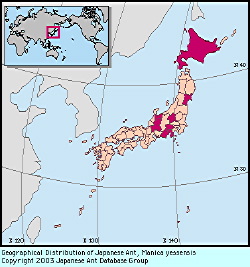
|
species
|
Manica yessensis
|
 |
Japanese Name
|
Tsuya-kushike-ari
|
Original Reference
|
|
Azuma, M. (1955) A list of ants from Hokkaido Is. Hyogo Biology 3: 1-2.
|
Description
|
|
Total length of workers around 5 - 7 mm. Head and gaster black, other parts brown, yellowish brown, or reddish brown. Mandibles armed with two large apical teeth and 10 or 11 denticles. Anterior clypeal margin slightly concave in the middle. Antennal scapes just reaching posterior border of head; abruptly bent at the base. Dorsal margin of promesonotum in lateral view smoothly connected with the metanotal groove. Metanotal groove deeply impressed both dorsally and laterally. Both sides of the transition area between the dorsal and declivitous faces of the propodeum slightly raised and obtusely angulate in lateral view. Dorsal faces of head, mesosoma and petiole longitudinally rugose. Standing hairs abundant on body. Tibial spurs of middle and hind legs simple (they are more or less pectinate in the other Manica species).
|
Remarks
|
|
The larvae of this species were described under the name "Manica sp." by Wheeler & Wheeler (1977). M. yessensis nests in the soil of volcanic mountains at gravelly sites with patchy vegetation, or under stones in dry river-beds. Dietary items include insects and honey dew. Winged reproductives emerge in August. Manica yessensis is sporadically distributed, perhaps in relation to its particular habitat preferences.
|
|

Distribution
|
|
Hokkaido, Honshu (the central part and northwards).
|
|
References
|
|
- Wheeler, G. C. & J. Wheeler (1977). Supplementary studies on ant larvae: Myrmicinae. . Trans. Am. Ent. Soc., 103, 581-602.
|
Editor
|
|
Original text by Keiichi Onoyama and Rikio Sonobe. English translation by Keiichi Onoyama, edited by Robert W. Taylor.?@Revised by Masashi Yoshimura.
|
|